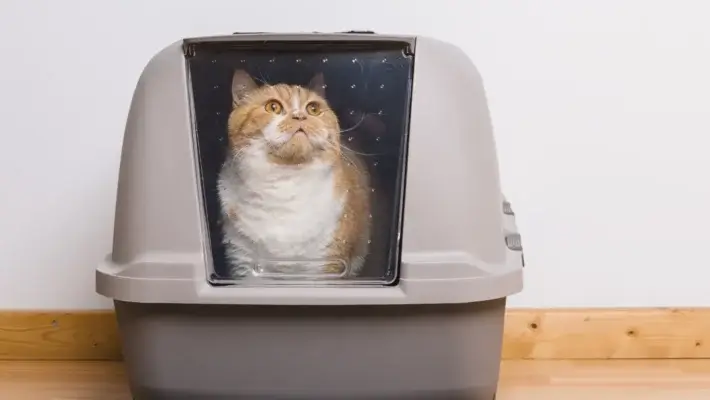Constipation is a common issue for cats that can cause significant discomfort. This in-depth guide covers the causes, symptoms, treatments, and preventative care you need to know about feline constipation. You can ensure your cat’s health and well-being by identifying the causes and taking steps to treat and prevent constipation.
Understanding Constipation in Cats
Mild constipation may cause a cat to strain or spend prolonged time in the litter box. More severe cases can result in a complete inability to defecate.
Constipation usually develops gradually over several days or weeks. Warning signs include:
- Infrequent bowel movements
- Difficulty or straining when trying to defecate
- Small, hard, dry feces
- Bloated or distended abdomen
- Signs of discomfort like vocalizing or licking the anal area
- Decreased appetite
- Lethargy
Contact your veterinarian If cat shows these symptoms. Severe constipation can become dangerous if left untreated.

Common Causes of Constipation in Cats
There are several causes of constipation in cats:
Dehydration
Dehydration is the most common cause of Constipation. It thickens the stool and makes it difficult to pass. Older cats are especially prone to dehydration as kidney disease and diabetes result in increased urine production. Providing ample fresh water is key.
Diet
Low-fiber diets or sudden diet changes can trigger constipation. Insufficient exercise can also contribute.
Intestinal Blockages
Foreign objects like hairballs or small toys can obstruct the colon. Hardened stool itself can also block the rectum.
Injuries and Growths
Anal gland impactions, tumors, past fractures, and arthritis can all narrow the colon or anus. This compression makes defecation difficult.
Megacolon
Megacolon occurs when the colon loses muscle tone and can’t push stool through the large intestine. It causes chronic constipation.
Medications
Some drugs like antihistamines, diuretics, and opiates have constipation as a side effect.
Stress and Anxiety
Stressful events like moving homes, adding pets, or schedule changes can delay bowel movements if a cat feels uncomfortable using the litter box.
Hypothyroidism
An underactive thyroid gland decreases gut motility, potentially leading to constipation.
Neurological Conditions
Nerve damage and spinal injuries may disrupt normal elimination signals. Treatment will depend on the underlying cause.
Diagnosing the Cause of Constipation
Veterinarians use several methods to diagnose the underlying reason for a cat’s constipation:
- Medical history – Previous conditions, medications, diet changes, and stressors.
- Physical exam – Palpating the abdomen, taking temperature, assessing hydration.
- Blood and urine tests – Check organ function and look for issues like diabetes.
- Fecal exam – Identify parasites that may be a factor.
- Abdominal x-rays or ultrasound – Evaluate stool buildup and look for blockages.
- Colonoscopy – Directly visualize the colon’s interior for obstructions.
- Biopsy – Take colon tissue samples to test for disease.
- Neurological assessment – Check spinal and pelvic nerve function.
Diagnostic tests help find any underlying disease contributing to the problem. Treatments can then be tailored to your cat’s specific needs.
Treating Feline Constipation
Several remedies can provide home treatment for mild constipation. Consult your veterinarian before giving your cat any medication or supplements.
Increase Hydration
Giving your cat more water is key. Try wet food, broths, tuna juice, or plain water. Fountains encourage drinking. Avoid stock cubes with added sodium.
Add Fiber
Fiber bulks up stool, stimulates gut motility, and eases passage. Mix canned pumpkin, wheat bran, or psyllium husk into your cat’s meals.
Use Laxatives
Lactulose pulls water into the colon to soften stool. It requires a prescription and dosage monitoring by your vet.
Ensure Adequate Exercise
Playing with string toys or lasers gets your cat moving and helps stimulate bowel movements.
Use Laxative Supplements
Hairball remedies containing petroleum or mineral oil can lubricate the colon. Ask your vet before use.
Relieve Discomfort
A warm compress on the abdomen can relax muscles. Massaging the area may also help ease stool passage.
Switch Litters
Experiment with different unscented clumping or sandy litter types
Add Moisture to Food
Warm water or low-sodium broth makes dry kibble easier to digest.
If home treatments don’t resolve constipation after a few days, veterinary intervention is required. Your vet has additional options for relieving obstipation.
Enemas
Phosphate enemas moisten the colon and stimulate defecation. These must be professionally administered.
Manual Evacuation
The vet may gently palpate the cat’s abdomen or directly remove feces from the rectum if severely impacted.
IV Fluids
Cats with dehydration may need subcutaneous or intravenous fluids to rehydrate the colon.
Medication Adjustments
Switching drugs or changing dosages if a medication is causing constipation as a side effect.
Surgery
For obstructions, strictures, or megacolon, surgery may be performed to remove blockages or widen the colon.
Preventing Constipation Recurrence
Once constipation has resolved, there are several ways to help prevent recurrence:
Encourage Drinking
Providing abundant fresh water prevents dehydration. Consider purchasing pet water fountains.
Feed High-Fiber Food
Choose cat food with listed whole grains like brown rice and added fiber content.
Incorporate Wet Food
The moisture in canned food or raw diets helps hydrate your cat.
Add Water to Dry Food
Splash hot water over kibble to soften it and create a broth.
Maintain an Exercise Routine
Interactive play helps mobilize your cat’s bowels. Try fishing pole toys and laser pointers.
Keep a Consistent Feeding Schedule
Feeding at the same times trains the colon to move stool at predictable intervals.
Add Probiotic Supplements
Probiotics support healthy gut flora and keep the GI tract functioning properly.
Use Gentle Laxatives Periodically
Consult your veterinarian about occasional lactulose use
Ensure Proper Litter Box Setup
Cats may hold stool if boxes are dirty, difficult to access, or intimidating.
Manage Stress
Limit major changes to your cat’s routine and environment when possible. Use calming aids like Feliway if needed.
Monitor Underlying Conditions
Keep chronic illnesses like kidney disease, arthritis and hypothyroidism well-controlled. With proactive care, hydration and a healthy diet and lifestyle, feline constipation can often be avoided.

When to See the Veterinarian
Despite preventative steps, constipation may still occur. Seek veterinary help right away if your cat shows these signs:
- No bowel movement in over 3 days
- Repeated straining or crying in litter box
- Loss of appetite for 24+ hours
- Vomiting
- Lethargy, depression, or hiding
- Distended abdomen, bloating
- Blood in stool
Severe constipation can become a life-threatening emergency. Cats can experience ruptures, megacolon, and even enter septic shock from toxins released by trapped stool.
Don’t delay. If your cat is showing concerning symptoms or not improving with home treatments, urgent veterinary care is needed. Prompt diagnosis and treatment can get your kitty’s bowels moving comfortably again.
If your newborn kitten is having trouble pooping, it could be a sign of constipation. Learn more about the causes and treatments for constipation in kittens in my article “Why My Kitten is Not Pooping“


